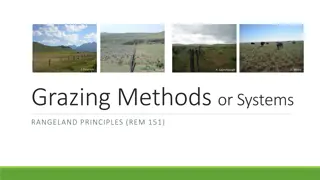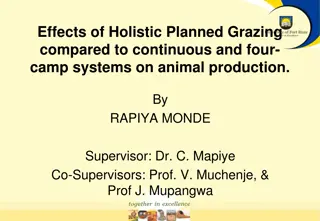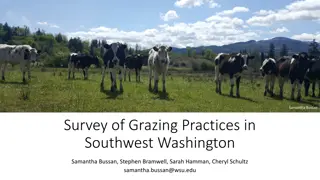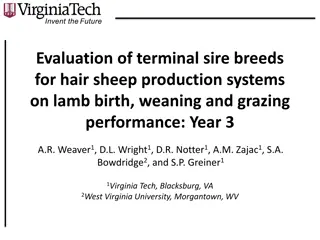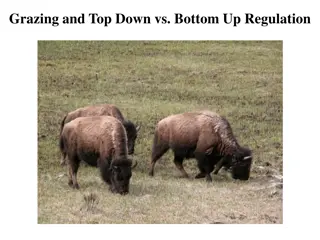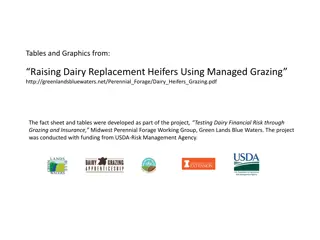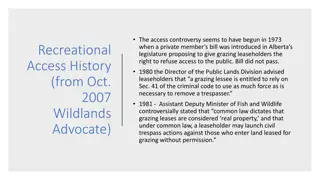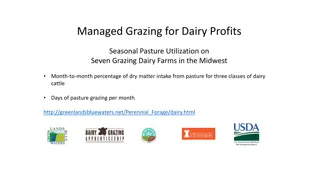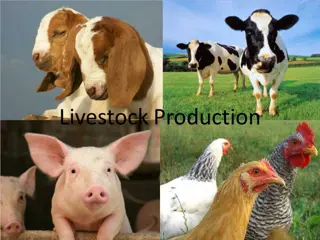Understanding Grazing Systems and Veld Types in Animal Production
This educational material covers various grazing systems, veld types, and the impact of different grazing animals on the vegetation. It discusses the importance of understanding veld types such as sweetveld, sourveld, and mixed-veld, and how factors like rainfall and soil texture influence these classifications. Additionally, it explores the characteristics of sourveld, sweetveld, and mixed-veld, emphasizing the importance of managing grazing to maintain the nutritional value of the vegetation. The content aims to enhance knowledge about grazing habits and how they affect land management in animal production contexts.
Download Presentation

Please find below an Image/Link to download the presentation.
The content on the website is provided AS IS for your information and personal use only. It may not be sold, licensed, or shared on other websites without obtaining consent from the author. Download presentation by click this link. If you encounter any issues during the download, it is possible that the publisher has removed the file from their server.
E N D
Presentation Transcript
SEFIKENG CAMPUS SUBJECT: ANIMAL PRODUCTION LEVEL: 3 MODULE: 3 UNIT: 1 GRAZING SYSTEMS AND VELD TYPES. LECTURER: MPHUTHI A.K
Subject outcome Identify and describe grazing systems in a work place environment. Learning outcome Identify and explain the grazing habits of sheep to enable the provision of suitable grazing.
Introduction Different types of grazing animals have different effects on the veld. Bulk grazers such as cattle, zebra or buffalo will graze on tall grass species. This will expose the shorter grass species for concentrate grazers such as sheep, springbok and blesbok. A farmer can increase the production efficiency of his or her land by keeping a mixed herd, since the different grazers will eat different species of grass on the same piece of veld.
1. Veld types The grazing system that is used in an area will be determined by the kind of veld or the type of grasses found in that area. One can distinguish between sweetveld, sourveld and mixed- veld. These kinds of veld are determined by two main environmental factors. Rainfall Soil texture
Veld types continues.. 1.1 Sourveld The two factors that lead to the development of sourveld are the following: - High average rainfall over the growing season of the plants - a coarse (sandy), well-drained soil. Sourveld is palatable and nutritional for animals when the plants are young. As the plant matures, the nutritional value and palatability decrease quickly. Sourveld must therefore be used for feeding animals while the plants are in the growing phase and are still green and palatable.
Veld types continues.. 1.2 Sweetveld The two factors that lead to the development of sweetveld are the following. - Low average rainfall over the growing season. - A fine-textured soil like clay with poor drainage. The vegetation in sweetveld is palatable and nutritious. It retains its nutritional value throughout all its stages of growth. It also stays palatable in its mature stage. Since sweetveld is both palatable and edible, there is a danger that the grazing animals will damage the sweetveld if grazing is not controlled.
Veld types continues.. 1.3 Mixed-veld The term mixed-veld is used for veld that is somewhere between extremely sour veld and extremely sweet veld.
2. Seasonal fluctuations of sour, sweet and mixed. 2.1 Characteristics of sourveld In the early stages of the rainy growing season, the veld is still green and highly palatable, edible and nutritional. As the grass becomes increasingly mature, the nutritional value decreases. During the dry winter season, sourveld consisting of grass only is totally useless. When sourveld also contains shrubs, bushes and low-growing trees, it is called savannah veld? A farmer cannot save a sourveld camp during the rainy summer days season by not allowing grazing there. Sourveld can withstand the grazing of animals quite well. However, overgrazing the veld will cause it to deteriorate.
Seasonal fluctuations continues 2.2 Characteristics of mixed-veld The characteristics of mixed-veld are somewhere in between those of sourveld and sweetveld. Mixed-veld is usually slower than sweetveld to grow out after it has rained. It takes longer to reach maturity. It provides a degree of palatable grazing during all seasons of the year. The carrying capacity of mixed-veld is higher during all seasons than sweetveld but it is lower than sourveld. Mixed-veld is not so vulnerable to overgrazing.
Seasonal fluctuation continues. 2.3 Characteristics of sweetveld Sweetveld has a relatively high nutritional value during all seasons of the year. As in the case of sourveld, sweetveld has its highest nutritional value when the grass is still young, green and short. The nutritional value also decreases as it becomes older. However the decrease in nutritional value of sweetveld is not as great as with sourveld. Sweetveld is more vulnerable to overgrazing than sourveld. Sweetveld can be grazed during the dry season, so it is often overgrazed.
3.Different grazing systems according to different veld types. 3.1 Grazing system for sourveld A system of quick rotation of grazing gives better results on sourveld than a system of continuous grazing. A four-camp rotational grazing system can be successfully applied on sourveld. With this system, one camp is left ungrazed for a full year. The other three camps are rotationally grazed during the year in such a way that each camp is grazed for one week and then rested for two weeks. The whole surface area of grazing pastures is rested for one year every four years.
Different grazing systems continues.. 3.2 Grazing systems for sweetveld Each camp on the farm should be rested at the end of the rainy season, which means is usually late summer. A second rest period should be allowed at the beginning of the rainy season (during early summer). Each camp on the farm should undergo a full years rest every five years.
Different grazing systems continues. 3.3 Grazing systems for mixed-veld It is not possible to programme the grazing of herds for a farm without knowing the mixed-veld kinds that grows there. Once this information is known, a general management programme can be used
Summary Different types of grazing animals have different effects on the veld. Sweetveld, sourveld and mixed-veld are determined by two main environmental factors that is rainfall and soil texture. There are factors that lead to the development of sourveld, sweetveld and mixed-veld. Seasonal fluctuations of sour, sweet and mixed-veld have different characteristics. There are different grazing systems according to different veld types.
Assessment Activity. Mention (two) environmental factors that a veld can be determined by? (2) What are (two) factors that lead to development of sourveld? (2) Mention characteristics of sweetveld under seasonal fluctuations. (4) What are the grazing systems for mixed veld? (2) Define rotational grazing and overgrazing. (4) Total marks: 14


